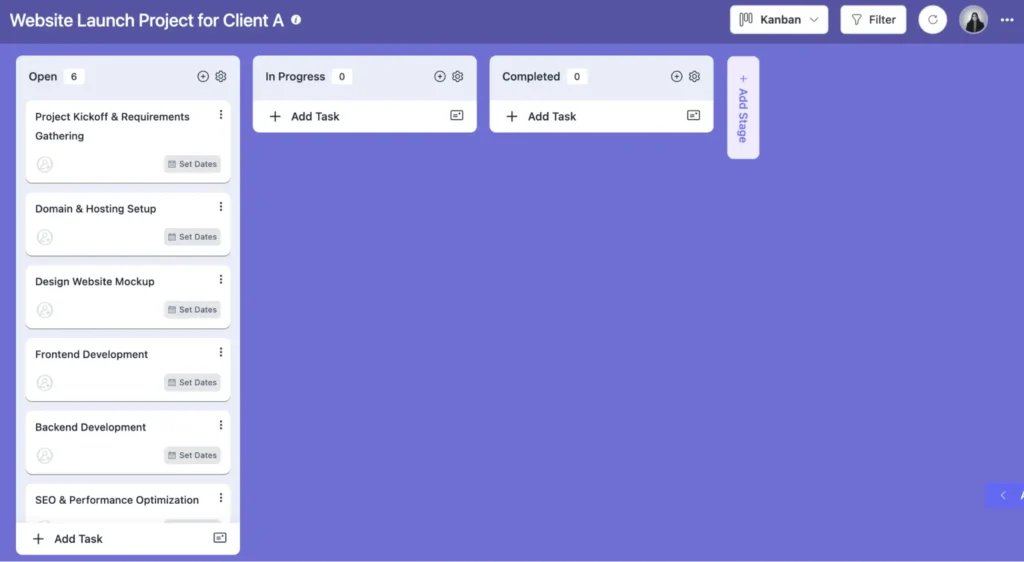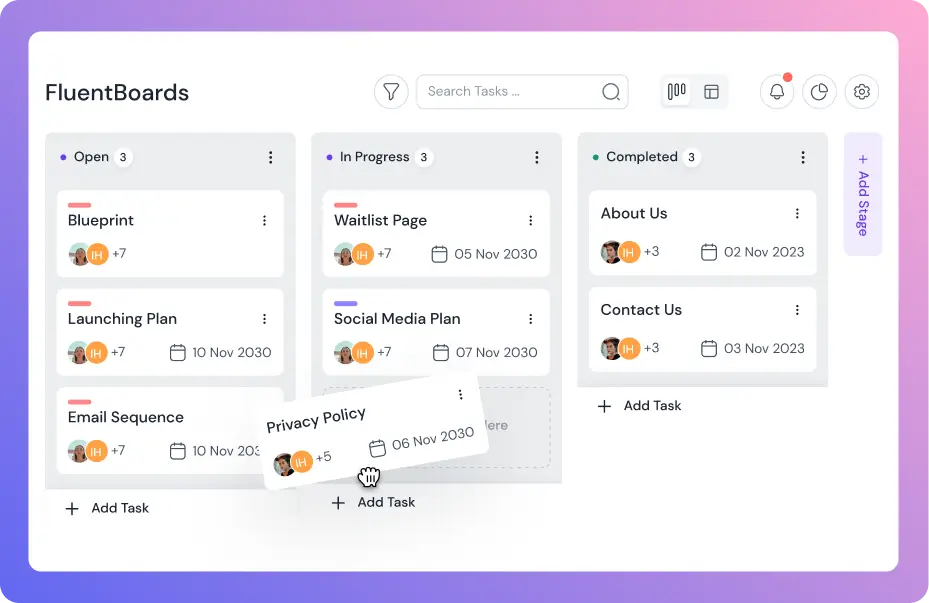
Project Scope Complete Guide: How to Define and Write Project Scope Clearly
Imagine firing an arrow with no target that keeps moving but never hits the mark. That’s exactly what happens when your projects run without a defined scope.
In fast-paced, stressful industries, this turns into:
- Endless requests with no control
- Misaligned priorities across departments
- Timelines that slip further every week
The root cause? Trying to accomplish everything without clear boundaries. As Louis Fried put it best, “Don’t do anything you don’t have to do.”
In this beginner’s guide, we’ll explore how to define and manage scope effectively so your projects stay on target.
Let’s dive in.
What is the Project Scope?
Project scope defines the boundaries of what’s included, what’s excluded, and how you’ll deliver the final outcome while managing your project workflow effectively throughout the project.
A complete project scope typically outlines:
- Goals and objectives you’re trying to achieve
- Deliverables you’ll produce
- Tasks and activities required
- Resources and timelines needed
- What’s NOT included (equally important!)
So, in essence, project scope keeps everyone aligned on what success looks like and ensures stakeholders understand the objectives and work required to achieve them.
Bonus Information That Might Help:
- Project scope creep is the uncontrolled expansion of project work beyond the originally defined project scope. It happens when new features, requirements, or tasks are added without proper approval or adjustments to the timeline and budget.
- A project scope statement is a formal document that defines what the project will deliver. This statement serves as a guide for project managers to clearly communicate expectations with both stakeholders and the project team.
Key Components of Project Scope: What Every Project Scope Must Include
A solid project scope typically includes:
- Project objectives: The purpose of the project and the outcomes it aims to achieve.
- Project deliverables: The specific results, products, or services the project is expected to produce.
- Scope of work: A clear outline of the tasks, activities, and processes required.
- Project timeline: Key project milestones, deadlines, and schedules to track progress.
- Budget & resources: Estimated costs and the resources allocated to complete the work.
- Exclusions & constraints: What’s outside the scope, plus any limitations or restrictions to keep in mind.
- Stakeholder roles: Defined roles, responsibilities, and expectations for team members and stakeholders.
Why is Project Scope Important?
Every project operates within the iron triangle: Scope + Time + Cost.
Change one, and the others must adjust. This is why experienced project managers prioritize clear scope definition from the start.
According to PMI, 52% of projects suffer from scope creep
Below are the key benefits of proper project scope:
- Provides Clear Focus: Well-defined scope sets clear boundaries for deliverables, ensuring everyone knows exactly what’s expected and reducing confusion.
- Defines team roles: With a clear project scope, everyone understands their roles and responsibilities, reducing confusion and ensuring the project team works together smoothly.
- Aligns all stakeholders: Documented scope ensures team members, clients, and sponsors work toward identical objectives, strengthening project team collaboration.
- Improves resource management: Clear scope enables effective allocation of time, money, and personnel, preventing both overallocation and underutilization.
- Manages expectations: Clear deliverables, timelines, and constraints create a shared understanding of what gets achieved and when.
- Prevents scope creep: Defined parameters stop unauthorized additions that derail budgets and timelines by providing instant criteria for evaluating new requests.
- Facilitates change management: Baseline scope statements provide frameworks for evaluating proposed changes and their impact on the project triangle.
- Enables risk mitigation: Early scope definition helps you spot potential project challenges and risks, so you can plan solutions before they turn into bigger problems.
Also Read: Why Project Management Matters
Project Scope vs Scope Management: What’s the Difference?
Understanding the difference between project scope and scope management is essential for project success. Here’s how they differ:
| Aspect | Project Scope | Scope Management |
| Purpose | Defines project boundaries and deliverables | Controls and monitors those boundaries |
| Focus | What are we building? | How do we control what we’re building? |
| When | Established during the project planning phase | Ongoing throughout all five phases of the project life cycle |
| Output | Scope statement, work breakdown structure | Change control processes, monitoring systems |
| Responsibility | Project manager with stakeholder input | Project manager with team execution |

Level up your WordPress project management game with this Trello equivalent solution – where limitless possibilities come at an unbeatable price!
How to Define and Write Project Scope Clearly
Let’s walk through how to define and write project scope properly-
Define project goals and objectives
Your project scope needs direction, and that starts with knowing what you’re trying to accomplish. To do it perfectly, understanding your project goals and objectives is a must!
Why this is important:
Project goals and objectives determine what work gets included in your scope and what gets excluded. Project goals give you the big picture, while objectives break down what success looks like. And, to define them effectively, make sure you clearly understand the differences between project goals and objectives.
When defining objectives for your project scope:
- Make them clear enough to guide scope decisions
- Include measurable outcomes so you know when you’ve achieved them
- Ensure they align with stakeholder expectations

Gather stakeholder requirements
With clear direction established, you need detailed input from everyone who has a stake in your project’s success. This is where your initial goals and objectives get refined into actionable scope boundaries.
Why this is important:
Stakeholders bring different perspectives on what should be accomplished and the constraints you may face in the long run. Listening to them carefully at the start and understanding their needs reduces the risk of scope creep later.
Focus on understanding their key requirements:
- Budget limitations and timeline expectations
- Quality standards and performance criteria
- Resource availability and technical constraints
- Success criteria and acceptance conditions
After you have this stakeholder input, you can refine your objectives using SMART goals based on real stakeholder needs rather than assumptions.
Not sure who your stakeholders are? Check out our full guide on identifying and managing project stakeholders!
Identify deliverables and tasks
Now translate your goals and objectives into tangible outputs. Focus on identifying exactly what the project is expected to produce.
Start by listing specific deliverables that stakeholders will receive, then break them into tasks using a work breakdown structure (WBS).

And for each deliverable, estimate required team members, budget, tools, and timeframes. This ensures your scope aligns with available resources and prevents overcommitting to unrealistic outputs.
Document exclusions and constraints
Make a list of what your project will NOT do. This prevents those awkward conversations later when stakeholders assume certain work was included.
Also, document your constraints, like budget limits, timeline restrictions, and resource availability.
Why this is important:
Your project’s success doesn’t depend only on what needs to be achieved, but also on what’s excluded. Exclusions and constraints together set boundaries that protect your project from unrealistic expectations.
Set project milestones
Your project scope needs progress checkpoints to track whether you’re staying within defined boundaries.
Why this is important:
Well-defined milestones help track progress and give stakeholders visibility into how the project is advancing. They also create natural opportunities to address whether you’re staying within scope or if adjustments are needed.
So, instead of saying “we’ll finish eventually,” give specific dates like “first draft due April 10” or “stakeholder review completed by month-end.”
Create and approve the scope statement
As we go through each step of defining scope, we’ve found the key pieces that hold the project together. Now it’s time to bring them into one document: your project scope statement.
Why this is important:
This vital document serves as your project’s go-to reference point that guides decisions and protects the project from drifting.
Your scope statement should capture:
- The goals and objectives you’re working toward
- The deliverables and milestones that mark progress
- The exclusions and constraints that set boundaries
And the real strength of this document comes when it’s shared. Get stakeholder approval and make it official. That sign-off turns your scope into a shared agreement, creating accountability and preventing scope creep before it starts.
Establish a change control process
Once your scope statement is locked in, you need one more safeguard. The question isn’t whether changes will happen, but how you’ll handle them when they do.
Projects evolve, and new requests will surface as work progresses. So, build a straightforward process for evaluating scope changes.
Why this is important:
This prevents small, well-meaning additions from snowballing into scope creep, creating clear decision points that keep the project focused and achievable.
When someone submits a request, ask three key questions:
- Does this align with our original goals?
- How will it affect our timeline and budget?
- Who has the authority to approve it?
Real-World Example of Defining Project Scope
To see how this works in practice, let’s walk through a real scenario.
Imagine our software company decides to add a live chat feature to improve customer support response times. And now to define the scope of this project, you follow these steps –
Project goals: Reduce customer support response times.
Project Objectives: Implement a live chat feature on the company website to reduce from 4 hours to 30 minutes.
Project deliverables: These are the tangible outputs of the project –
- A fully functional chat widget integrated into the company’s support pages
- Admin dashboard for support agents to manage conversations and view chat history
- Integration with the existing ticketing system for seamless case management
- Staff training materials covering chat protocols and response best practices
- Performance analytics dashboard to monitor response times and customer satisfaction
In-scope items: This section clarifies what is included in the project –
- Real-time text-based chat functionality during business hours
- Ability to handle up to 50 concurrent chat sessions
- File sharing capabilities for screenshots and documents
- Integration with existing CRM software for customer identification
- Automated chat routing to available agents
Out-of-scope items: This prevents misunderstanding by clearly stating what the project will not include:
- Video or voice chat functionality
- AI chatbot or automated response features
- Mobile app chat integration
- Multilingual support capabilities
- Social media messaging platform integration
Project constraints and assumptions: These are the limiting factors and assumptions for the project –
- Budget cannot exceed $75,000
- The timeline must be completed within three months before the holiday season
- Two developers and one UX designer are allocated part-time to the project
- Assumption that existing infrastructure can handle increased chat traffic
- The support team can dedicate time to training during implementation
Key milestones: Critical checkpoints throughout the project timeline –
- Week 2: Complete widget design and user testing
- Week 4: Finish system integration and internal testing
- Week 6: Conduct support team training sessions
- Week 8: Launch chat feature to customers
- Week 12: Deliver first performance analysis report
Project scope statement and change control process: Now you’ll bring together all the information you’ve gathered so far, develop a detailed project scope statement, and share it with stakeholders for approval. Additionally, you will clarify how you will respond if any mandatory changes arise.
Common Challenges You’ll Face When Defining Project Scope
Common challenges you may encounter when defining project scope:
- Small client requests gradually expand into major scope overhauls that double original timelines and budgets
- Stakeholders provide vague requirements, then expect precise deliverables that they never clearly articulated
- Multiple departments push conflicting priorities without considering the impact on overall project success
- Teams interpret the same scope statement differently, creating duplicated work and missed deliverables
- Budget limitations force scope reductions that compromise the project’s core value and effectiveness
- Missing exclusions create false expectations for stakeholders, causing conflicts during project execution
- Deadline pressure rushes scope definition, creating critical gaps discovered only during implementation
- Overly detailed scope documents become reference materials that teams find too complex to follow

Step into the Future of Project Management!
Scope First, Success Follows
Project scope isn’t documentation gathering dust on your desk; it’s the strategic foundation that separates successful projects from costly disasters. Rather, to some extent, it works as the decider between project success and failure!
So, define your project scope clearly, and when scope creep knocks on your door disguised as “simple requests,” make clear decisions based on agreed boundaries, not emotional appeals.
Thanks for reading, and remember that when scope comes first, success will always follow.
Let’s redefine project management with FluentBoards!
Get Tips, Tricks, & Updates
We won’t send you spam.









![how to create a project management workflow [x steps] (2)](https://fluentboards.com/wp-content/uploads/2025/11/How-to-create-a-project-management-workflow-x-steps-2-768x402.webp)





Leave a Reply